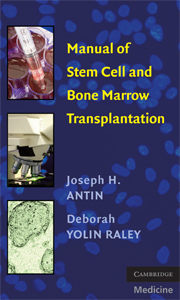Book contents
- Frontmatter
- Contents
- Acknowledgments
- Manual of Stem Cell and Bone Marrow Transplantation
- 1 Rationale for Transplantation
- 2 Types of Transplantation
- 3 HLA Matching in Allogeneic Transplantation
- 4 Stem Cell Source
- 5 Pretransplant Evaluation and Counseling of Patient and Donor
- 6 Conditioning Regimens
- 7 Stem Cell Infusion
- 8 ABO Compatibility
- 9 Engraftment
- 10 Preventative Care
- 11 Transplant-Related Complications
- 12 Graft-Versus-Host Disease – Prophylaxis and Acute
- 13 Graft-Versus-Host Disease – Chronic
- 14 Engraftment Syndrome
- 15 Infectious Disease
- 16 Graft Rejection And Failure
- 17 Gastrointestinal Complications
- 18 Pulmonary Complications
- 19 Veno-Occlusive Disease
- 20 Special Transfusion-Related Situations
- 21 Cardiovascular Complications
- 22 Neurologic Complications
- 23 Cystitis
- 24 Donor Lymphocyte Infusion
- 25 Transplantation: Regulation And Accreditation
- Appendix
- Index
19 - Veno-Occlusive Disease
Published online by Cambridge University Press: 23 November 2009
- Frontmatter
- Contents
- Acknowledgments
- Manual of Stem Cell and Bone Marrow Transplantation
- 1 Rationale for Transplantation
- 2 Types of Transplantation
- 3 HLA Matching in Allogeneic Transplantation
- 4 Stem Cell Source
- 5 Pretransplant Evaluation and Counseling of Patient and Donor
- 6 Conditioning Regimens
- 7 Stem Cell Infusion
- 8 ABO Compatibility
- 9 Engraftment
- 10 Preventative Care
- 11 Transplant-Related Complications
- 12 Graft-Versus-Host Disease – Prophylaxis and Acute
- 13 Graft-Versus-Host Disease – Chronic
- 14 Engraftment Syndrome
- 15 Infectious Disease
- 16 Graft Rejection And Failure
- 17 Gastrointestinal Complications
- 18 Pulmonary Complications
- 19 Veno-Occlusive Disease
- 20 Special Transfusion-Related Situations
- 21 Cardiovascular Complications
- 22 Neurologic Complications
- 23 Cystitis
- 24 Donor Lymphocyte Infusion
- 25 Transplantation: Regulation And Accreditation
- Appendix
- Index
Summary
Hepatic Veno-occlusive disease (VOD) (sometimes referred to as sinusoidal obstruction syndrome [SOS]) is a process of central venular occlusion characterized by sinusoidal endothelial injury, subendothelial edema, intrahepatic obstruction of blood flow, hepatocellular necrosis, and intense fibrosis. Its pathophysiology is complex but reflects a cascade of drug toxicity, cytokine injury, and hypoxic, free radical-mediated damage to Zone 3 of the hepatic acinus. It occurs in 5% to 20% of patients and ranges from a mild self-limiting illness to a severe disease with almost universal fatality. It generally occurs early after conditioning, that is, day 0 to 30 (although later onset can occur).
RISK FACTORS
It is important to try to identify patients at high risk for VOD early. In doing so, preventative measures (such as reducing sinusoidal toxins) can be implemented.
Multiple alkylating agents in conditioning regimen (especially cyclophosphamide, busulfan, and BCNU), total body irradiation (TBI), liver disease pre transplant (as reflected increased SGOT), second or greater transplant, allogeneic donor (significantly less common after auto HSCT and after T-cell-depleted allogeneic HSCT, Mylotarg exposure (especially if within 3 to 4 months of HSCT).
Sirolimus in association with high-dose regimens, particular busulfan.
Other associations include high-dose IVIG use, recurrent febrile episodes, estrogen administration and prior viral hepatitis, nonalcoholic steatohepatitis, previous transplantation (as mentioned earlier), iron overload, and liver involvement with tumor.
- Type
- Chapter
- Information
- Manual of Stem Cell and Bone Marrow Transplantation , pp. 139 - 143Publisher: Cambridge University PressPrint publication year: 2009



